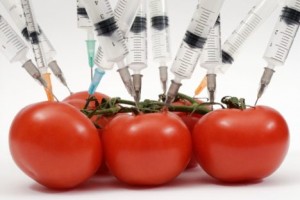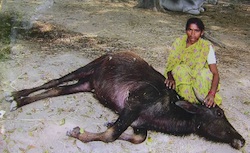 By Jeffrey Smith – responsibletechnology.org
By Jeffrey Smith – responsibletechnology.org
When U.S. regulators approved Monsanto’s genetically modified “Bt” corn, they knew it would add a deadly poison into our food supply. That’s what it was designed to do. The corn’s DNA is equipped with a gene from soil bacteria called Bt (Bacillus thuringiensis) that produces the Bt-toxin. It’s a pesticide; it breaks open the stomach of certain insects and kills them.
But Monsanto and the Environmental Protection Agency (EPA) swore up and down that it was only insects that would be hurt. The Bt-toxin, they claimed, would be completely destroyed in the human digestive system and not have any impact on all of us trusting corn-eating consumers.
Oops. A study just proved them wrong.
[pro_ad_display_adzone id=”110028″]
Doctors at Sherbrooke University Hospital in Quebec found the corn’s Bt-toxin in the blood of pregnant women and their babies, as well as in non-pregnant women.(i) (Specifically, the toxin was identified in 93% of 30 pregnant women, 80% of umbilical blood in their babies, and 67% of 39 non-pregnant women.) The study has been accepted for publication in the peer reviewed journal Reproductive Toxicology.
According to the UK Daily Mail, this study, which “appears to blow a hole in” safety claims, “has triggered calls for a ban on imports and a total overhaul of the safety regime for genetically modified (GM) crops and food.” Organizations from England to New Zealand are now calling for investigations and for GM crops to be halted due to the serious implications of this finding.
Links to allergies, auto-immune disease, and other disorders
There’s already plenty of evidence that the Bt-toxin produced in GM corn and cotton plants is toxic to humans and mammals and triggers immune system responses. The fact that it flows through our blood supply, and that is passes through the placenta into fetuses, may help explain the rise in many disorders in the US since Bt crop varieties were first introduced in 1996.
In government-sponsored research in Italy (ii), mice fed Monsanto’s Bt corn showed a wide range of immune responses. Their elevated IgE and IgG antibodies, for example, are typically associated with allergies and infections. The mice had an increase in cytokines, which are associated with “allergic and inflammatory responses.” The specific cytokines (interleukins) that were elevated are also higher in humans who suffer from a wide range of disorders, from arthritis and inflammatory bowel disease, to MS and cancer (see chart).
| Elevated interleukins | Associations |
| IL-6 | Rheumatoid arthritis, inflammatory bowel disease, osteoporosis, multiple sclerosis, various types of cancer (multiple myeloma and prostate cancer) |
| IL-13 | Allergy, allergic rhinitis, ALS (Lou Gehrig’s disease) |
| MIP-1b | Autoimmune disease and colitis. |
| IL-12p70 | Inflammatory bowel disease, multiple sclerosis |
The young mice in the study also had elevated T cells (gamma delta), which are increased in people with asthma, and in children with food allergies, juvenile arthritis, and connective tissue diseases. The Bt corn that was fed to these mice, MON 810, produced the same Bt-toxin that was found in the blood of women and fetuses.
When rats were fed another of Monsanto’s Bt corn varieties called MON 863, their immune systems were also activated, showing higher numbers of basophils, lymphocytes, and white blood cells. These can indicate possible allergies, infections, toxins, and various disease states including cancer. There were also signs of toxicity in the liver and kidneys.(iii)
Is GMO food creating a pesticide factory within your intestines? Watch this two minute video called Double Dipping Danger to find out the answer (produced by Alex Bogusky).
[vimeo 23976975 650 500]
Natural Bt is dangerous
Farmers have used Bt-toxin from soil bacteria as a natural pesticide for years. But they spray it on plants, where it washes off and biodegrades in sunlight. The GM version is built-in; every plant cell has its own spray bottle. The toxin doesn’t wash off; it’s consumed. Furthermore, the plant-produced version of the poison is thousands of times more concentrated than the spray; is designed to be even more toxic; and has properties of known allergens—it actually fails the World Health Organization’s allergen screening tests.(iv)
The biotech companies ignore the substantial difference between the GM toxin and the natural bacteria version, and boldly claim that since the natural spray has a history of safe use in agriculture, it’s therefore OK to put the poison directly into our food. But even this claim of safe use of Bt spray ignores peer-reviewed studies showing just the opposite.
When natural Bt-toxin was fed to mice, they had tissue damage, immune responses as powerful as cholera toxin (v), and even started reacting to other foods that were formerly harmless.(vi) Farm workers exposed to Bt also showed immune responses.(vii) The EPA’s own expert Scientific Advisory Panel said that these mouse and farm worker studies “suggest that Bt proteins could act as antigenic and allergenic sources.”(viii) But the EPA ignored the warnings. They also overlooked studies (ix) showing that about 500 people in Washington state and Vancouver showed allergic and flu-like symptoms when they were exposed to the spray when it was used to kill gypsy moths.
Bt cotton linked to human allergies, animal deaths

Indian farm workers are suffering from rashes and itching and other symptoms after coming into contact with Bt cotton.

All thirteen buffalo of a small Indian village died after grazing for a single day on Bt cotton plants.
It gets worse.
When they allow livestock to graze on the Bt cotton plants after harvest, thousands of sheep, goats, and buffalo died. Numerous others got sick. I visited one village where for seven to eight years they allowed their buffalo to graze on natural cotton plants without incident. But on January 3rd, 2008, they allowed their 13 buffalo to graze on Bt cotton plants for the first time. After just one day’s exposure, all died. The village also lost 26 goats and sheep.
One small study in Andhra Pradesh reported that all six sheep that grazed on Bt cotton plants died within a month, while the three controls fed natural cotton plants showed no adverse symptoms.
Living pesticide factories inside us?
Getting back to the Bt-toxin now circulating in the blood of North American adults and newborns—how did it get there? The study authors speculate that it was consumed in the normal diet of the Canadian middle class. They even suggest that the toxin may have come from eating meat from animals fed Bt corn—as most livestock are.
I’d like to speculate on another possible source. But I warn you, it’s not pretty.
The only human feeding study every published on genetically modified organisms (GMOs) was conducted on Roundup Ready soybeans. Here’s their back story: Scientists found bacteria growing in a chemical waste dump near their factory, surviving the presence of Monsanto’s Roundup herbicide. The herbicide normally kills bacteria, but this organism had some special gene that allowed it to survive. So Monsanto scientists figured, “Let’s put it into the food supply!”
By forcing that genes from that bacterium into soybean plants’ DNA, the plants then survive an otherwise deadly dose of Roundup herbicide—hence the name Roundup Ready.
In the human study (x), some of the subjects were found to have Roundup Ready gut bacteria! This means that sometime in the past, from eating one or more meals of GM soybeans, the gene that had been discovered in the chemical waste dump and forced into the soy, had transferred into the DNA of bacteria living inside their intestines—and continued to function. That means that long after we stop eating GMOs, we may still have dangerous GM proteins produced continuously inside of us.
When the results of the study emerged, the funding from the pro-GMO UK government mysteriously dried up, so they were not able to see if the same type of gene transfer happens with Bt genes from, say, corn chips. If it does, it means that eating Bt corn might turn our intestinal flora into living pesticide factories—continually manufacturing Bt-toxin from within our digestive systems.
I don’t know of a test that can confirm that this is happening, but the Canada study may be showing the results—where Bt-toxins are found in the blood of a very high percentage of people.
If the “living pesticide factory” hypothesis is correct, we might speculate even further. Bt-toxin breaks open the stomach of insects. Could it similarly be damaging the integrity of our digestive tracts? The biotech companies insist that Bt-toxin doesn’t bind or interact with the intestinal walls of mammals, and therefore humans. But here too they ignore peer-reviewed published evidence showing that Bt-toxin does bind with mouse small intestines and with intestinal tissue from rhesus monkeys.(xi) In the former study, they even found “changes in the electrophysiological properties” of the organ after the Bt-toxin came into contact.(xii)
If Bt-toxins were causing leaky gut syndrome in newborns, the passage of undigested foods and toxins into the blood from the intestines could be devastating. Scientists speculate that it may lead to autoimmune diseases and food allergies. Furthermore, since the blood-brain barrier is not developed in newborns, toxins may enter the brain causing serious cognitive problems. Some healthcare practitioners and scientists are convinced that this is the apparent mechanism for autism.
Thus, if Bt genes were colonizing the bacteria living in the digestive tract of North Americans, we might see an increase in gastrointestinal problems, autoimmune diseases, food allergies, and childhood learning disorders—since 1996 when Bt crops came on the market. Physicians have told me that they indeed are seeing such an increase.
The discovery of Bt-toxin in our blood does not confirm all this speculation, but it does provide food for thought. And hopefully, that food is non-GMO.
Our Institute for Responsible Technology joins other organizations worldwide calling for an immediate ban on GM food crops, and the commencement of rigorous independent scientific research on the safety of GMOs in general, and Bt-toxin in particular.
Jeffrey M. Smith is the Executive Director of the Institute for Responsible Technology, author of the #1 international bestselling book on GMOs, Seeds of Deception, and of Genetic Roulette: The Documented Health Risks of Genetically Engineered Foods. To avoid GMOs, which is the advice of the American Academy of Environmental Medicine, visit www.NonGMOShoppingGuide.com.
Click the below picture for a Wake Up World Only Special Offer

i Aris A, Leblanc S. Maternal and fetal exposure to pesticides associated to genetically modified foods in Eastern Townships of Quebec, Canada. Reprod Toxicol (2011), doi:10.1016/j.reprotox.2011.02.004 http://www.ncbi.nlm.nih.gov/pubmed/21338670
ii Finamore A, Roselli M, Britti S, Monastra G, Ambra R, Turrini A and Mengheri E. (2008). Intestinal and peripheral immune response to MON810 maize ingestion in weaning and old mice. J Agric Food Chem, 16 November 2008
iii Seralini GE, Cellier D, Spiroux de Vendomois J. 2007, “New analysis of a rat feeding study with a genetically modified maize reveals signs of hepatorenal toxicity”. Arch Environ Contam Toxicol. 2007;52:596-602; and Vendà´mois, JS, François Roullier, Dominique Cellier and Gilles-Eric Séralini. 2009, “A Comparison of the Effects of Three GM Corn Varieties on Mammalian Health” . International Journal of Biological Sciences 2009; 5(7):706-726
iv Gendel, “The use of amino acid sequence alignments to assess potential allergenicity of proteins used in genetically modified foods,” Advances in Food and Nutrition Research 42 (1998), 45–62. See also: G. A. Kleter and A. A. C. M. Peijnenburg, “Screening of transgenic proteins expressed in transgenic food crops for the presence of short amino acid sequences indentical to potential, IgE-binding linear epitopes of allergens,” BMC Structural Biology 2 (2002): 8–19; H. P. J. M. Noteborn, “Assessment of the Stability to Digestion and Bioavailability of the LYS Mutant Cry9C Protein from Bacillus thuringiensis serovar tolworthi,” Unpublished study submitted to the EPA by AgrEvo, EPA MRID No. 447343-05 (1998); and H. P. J. M. Noteborn et al, “Safety Assessment of the Bacillus thuringiensis Insecticidal Crystal Protein CRYIA(b) Expressed in Transgenic Tomatoes,” in Genetically modified foods: safety issues, American Chemical Society Symposium Series 605, eds. K.H. Engel et al., (Washington, DC, 1995): 134–47.
Bt protein failed to break down quickly in a simulated digestive solution. In fact, it left fragments that were typically the size of allergens. The Bt also failed the heat stability test, and had shared 9–12 amino acid sequences of vitellogenin, an egg yolk allergen.
v Vazquez et al, “Intragastric and intraperitoneal administration of Cry1Ac protoxin from Bacillus thuringiensis induces systemic and mucosal antibody responses in mice,” 1897–1912; Vazquez et al, “Characterization of the mucosal and systemic immune response induced by Cry1Ac protein from Bacillus thuringiensis HD 73 in mice,” Brazilian Journal of Medical and Biological Research 33 (2000): 147–155; See also L. Moreno-Fierros, N. Garcia, R. Lopez-Revilla, R. I. Vazquez-Padron, “Intranasal, rectal and intraperitoneal immunization with protoxin Cry1Ac from Bacillus thuringiensis induces compartmentalized serum, intestinal, vaginal, and pulmonary immune responses in Balb/c mice,” Microbes and Infection 2 (2000): 885–90.
vi Vazquez et al, “Bacillus thuringiensis Cry1Ac protoxin is a potent systemic and mucosal adjuvant,” Scandanavian Journal ofImmunology 49 (1999): 578–584. See also Vazquez-Padron et al., 147 (2000).
vii I.L. Bernstein et al, “Immune responses in farm workers after exposure to Bacillus thuringiensis pesticides,” Environmental Health Perspectives 107, no. 7(1999): 575–582.
viii EPA Scientific Advisory Panel, “Bt Plant-Pesticides Risk and Benefits Assessments,” March 12, 2001: 76.
ix Washington State Department of Health, “Report of health surveillance activities: Asian gypsy moth control program,” (Olympia, WA: Washington State Dept. of Health, 1993); and M. Green, et al., “Public health implications of the microbial pesticide Bacillus thuringiensis: An epidemiological study, Oregon, 1985-86,” Amer. J. Public Health 80, no. 7(1990): 848–852.
x Netherwood, T. (2004) “Assessing the survival of transgenic plant DNA in the human gastrointestinal tract”. Nature Biotechnology, 22, 204-209.
xi Noteborn et al, “Safety Assessment of the Bacillus thuringiensis Insecticidal Crystal Protein CRYIA(b) Expressed in Transgenic Tomatoes,” 134–47.
xii Vazquez et al, “Cry1Ac protoxin from Bacillus thuringiensis sp. kurstaki HD73 binds to surface proteins in the mouse small intestine,” 54–58.
[pro_ad_display_adzone id=”110027″]






